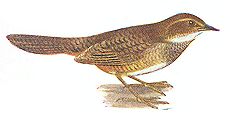Facts About Noisy scrubbird
The noisy scrub-bird is a remarkable avian species found exclusively in the coastal heaths of southwestern Australia. With its dark brown back, rust-colored wings, and speckled chestnut breast, it is visually striking. Males also feature a distinctive black triangle on their throats. These birds typically feed on small invertebrates, foraging in dense understory vegetation.
Once believed extinct, the noisy scrub-bird made a surprising reappearance when it was rediscovered in the 1960s at Two Peoples Bay in Western Australia. Since then, conservationists have devoted significant efforts to protecting this rare species, including relocating some populations to Bald Island and the Porongurup Ranges. The scrub-bird has very specific habitat requirements, favoring dense ground cover, especially in areas recovering from environmental disturbance.
Regarding reproduction, these birds reach maturity at around five years old and typically lay only one or two eggs per clutch. They construct their nests in low shrubbery, which provides some degree of protection. Unfortunately, the noisy scrub-bird is listed as threatened on the IUCN Red List. Its population is declining due to threats such as forest fires, predation, habitat degradation, and climate change.
Conservation efforts are concentrated on predator control, habitat management, and population monitoring. However, challenges persist, including the spread of the harmful fungus Phytophthora cinnamomi, which affects forest biodiversity. Moreover, translocation efforts have yielded mixed results due to the bird's stringent habitat preferences.
The most effective approach to protect the noisy scrub-bird involves meticulous monitoring, controlling forest fires, and managing their native habitats to ensure previous conservation successes are sustained.
